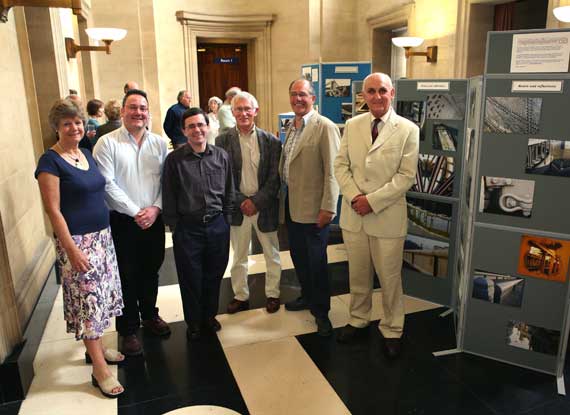|
|




Avon Industrial Buildings Trust was
set up in 1982 with the twin objectives of assisting to preserve the
industrial heritage of the area and also to act as a focus for interest
in industrial archaeology. A charity, AIBT has completed major projects
such as Saltford Brassworks, restoring the Midford Aqueduct on the
Somersetshire Coal canal and currently Brandy Bottom Colliery near
Emersons Green.
AIBT had run a very successful
photo project on the Coal canal and considered that the Brunel celebrations
would be a good way of introducing a wider range of people to our industrial
heritage.
The AIBT website is at www.aibt.org.
Brunel Through the Lens
This project was an exploration of the impact of Brunel on the city of
Bristol that encouraged a wide cross section of people, groups and
communities from the area to celebrate, learn and interpret the legacy
of Brunel through photographic images.
Project events
Workshop: 23 February at Bristol Zoo Education Centre. This attracted
around 30 people for a talk about Brunel combined with a practical
workshop on photographic methods.
Guided photo walk: 5 March. This comprised
a guided walk around Cumberland Basin and a separate boat trip around
Floating Harbour and to Hanham Lock. Both events were well attended and
the blend of interesting Brunel information and photographic aid was
enthusiastically welcomed. Over 1,000 images were taken and submitted
for projection and criticism.
Exhibition: 18-20 April at L-Shed. This exhibition of photos
was displayed during performances of acta’s Castles in the Air
community play. With 555 people visiting the play over four nights, it
was a good opportunity for a completely different audience to see the
exhibition.
Photo competition: 80 photos selected. There was
a good but not overwhelming number of entries (approx 120) to this
competition. The images were of a high standard and mostly digital
in format. There were no entries in the Junior class, reflecting AIBT’s
lack of success in reaching the younger generation.
Main exhibition: 8-19
May, Council House, College Green, Bristol. The original AIBT exhibition
was enhanced by the winners of the photo competition and was displayed
in the foyer of Bristol Council House for two weeks. The desk staff told
AIBT that many people had viewed the exhibition which was open not only
in office hours but also in the evenings when Council meetings took place.
Scout
exhibition: 23-25 June, Wodehouse Down,
Almondsbury, South Gloucestershire. It was agreed that this proposed
exhibition would be shown at a Scouts and Guides weekend at Wodehouse
Park. The organisers were very keen and the event would have reached
200+ youngsters. Unfortunately, ultimately the organisers declined,
as they were concerned about transport and security. The exhibition
is still mounted and AIBT hopes to exhibit it in local libraries.

Evaluation
Communication with schools and young people proved to be very difficult
and AIBT never succeeded in involving any young people in spite of much
effort by post and phone.
AIBT succeeded in obtaining press publicity via Bristol’s Evening
Post and the BBC and this was mainly due to AIBT’s own efforts.
The group felt that that it was on its own with regard to publicity.
They were not surprised as they were only a small project, but they expected
that this would be Brunel 200’s main benefit to the project.
Due to concerns about lack of publicity for the exhibition at the Council
House AIBT members visited every shop in the area with posters.
Survey forms were distributed and proved useful after the
walk and workshop. Attendees were largely satisfied and gave useful comments.
Goals
Overall, all of the goals of the project were attained. All of the events
took place and were judged very successful and the project was within
budget.
The failure to reach young people was disappointing particularly since
a good deal of effort was expended on this.
Learning points
A good organisational framework is essential in order to share the workload
and also as back up when people are unavailable.
Whilst AIBT knew publicity was vital, they believe even more effort/expense
would have paid dividends. They learnt that publicity needs to be both
eye-catching but also get over its message very quickly.
They concluded that they probably needed younger participants with experience
in the field to reach young people so would include a cost for such assistance
in any future project.
The co-operation between AIBT and NWBCC was mutually beneficial and enjoyable.
It could well lead to further ventures in the future.
Links
www.nwbcc.org.uk/brunel200
Photography: Mark Simmons.
|
|